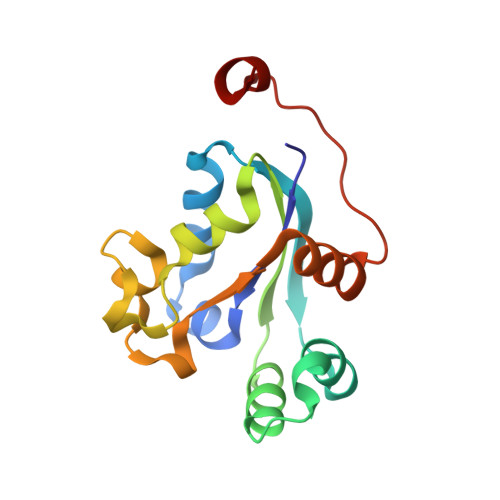Crystal structure of nucleoside diphosphate kinase required for coleoptile elongation in rice (Oryza sativa L.).
Huang, J.Y., Chang, T., Chang, C.Y., Chen, C.J.(2005) J Struct Biol 150: 309-318
- PubMed: 15890279
- DOI: https://doi.org/10.1016/j.jsb.2005.02.010
- Primary Citation of Related Structures:
1PKU - PubMed Abstract:
Nucleoside diphosphate kinase (NDK) is a ubiquitous enzyme found in all organisms and cell types, and catalyzes the transfer of the phosphoryl group from a nucleoside triphosphate to a nucleoside diphosphate. The enzyme is involved in and required for coleoptile elongation in rice as the level of the rice NDK (rNDK) changes during seed germination and the early stages of seedling growth. The expression of rice NDK gene is up-regulated in the growing coleoptiles when the anaerobic stress persists. The rNDK structure determined at 2.5 A resolution consists of a four-stranded anti-parallel beta-sheet, of which the surfaces are partially covered with six alpha-helices; its overall and active site structures are similar to those of homologous enzymes except the major conformation variations of residue 132-138 regions, involving significant structural contacts. The model contains 148 residues of 149 residues in total and averaged 19 water molecules per monomer for 12 molecules in an asymmetric unit. A mold of 12 superimposed molecules shows that the alphaA-alpha2 area has greater variations and higher temperature factors, indicating the flexibility for a substrate entrance. Hexameric molecular packing in both crystal and solution implies that rNDK functions as hexamers. This rNDK structure, which is the first NDK structure from a higher plant system, provides the structural information essential to understand the functional significance of this enzyme during growth and development in both rice and other plants.
Organizational Affiliation:
Biology Group, Research Division, National Synchrotron Radiation Research Center, Hsinchu 30076, Taiwan.














